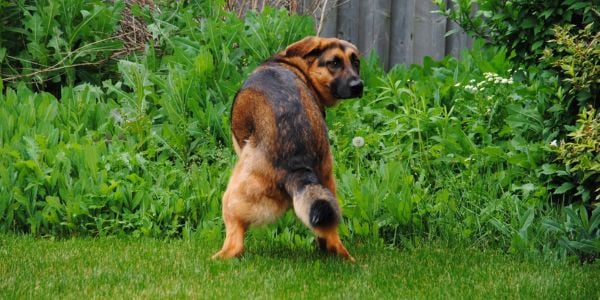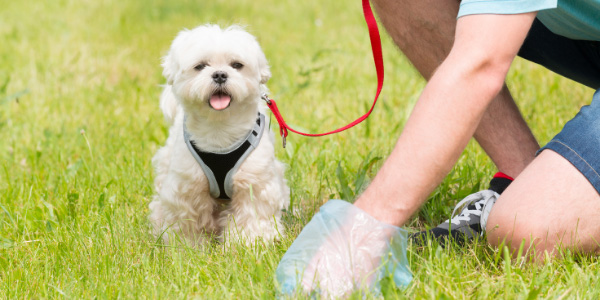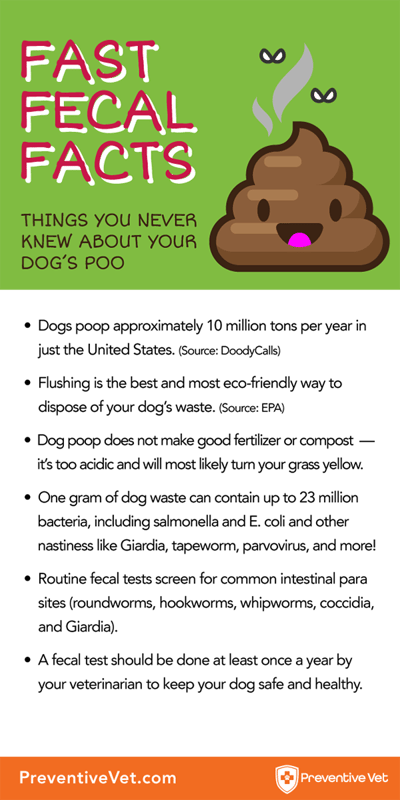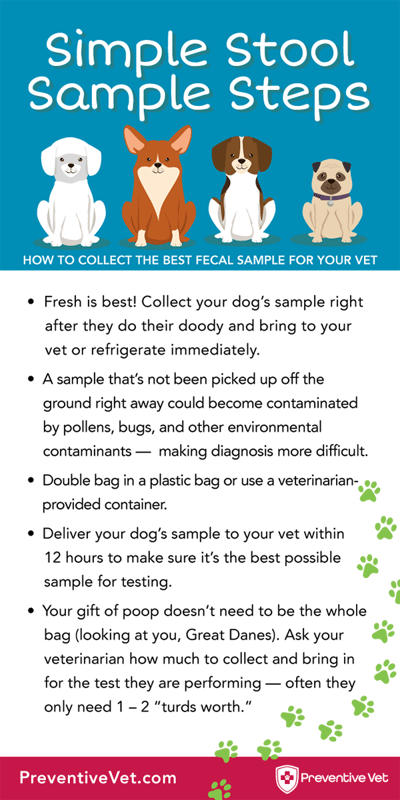
Pooping is a fact of life, but nobody wants to talk about it since it is ‘stinky’ business. But we vets love to discuss and evaluate your dog’s poop because it can provide us with some good clues about their health and behaviors, and if we are lucky, it can help us with a diagnosis.
Since the study of ‘poop-ology’ works best as a team effort, it would be great for you to go outside with your dog when they go to the bathroom and generally pay attention to their poops. If they can do it for you each time you use the bathroom, you can do it for them a couple times per day!
While I understand it's not the most desirable of pastimes, 'poop watching' has its benefits. It helps you know what your dog's poop looks like normally, so you can catch it when it's not normal. It helps with knowing your dog's poop schedule and gives some insight into how they are pooping (e.g., are they poop walking or straining to poop). All these factors will help you know if things are passing normally or if there's a potential issue.
Skip to section:
What Your Dog's Poo Is Telling You
Whether or not the "poop(ing) characteristics" discussed below warrant a veterinary visit and how soon depends on a multitude of factors, such as:
- How long they've been going on?
- How severe they are?
- What is your dog's appetite?
- Are there any changes in energy level?
- Are they vomiting?
- And a host of other things!
As with most things, though, the earlier you catch potential poop problems, the better it will be for your dog and you.
So going to the bathroom “together” with your dog regularly – i.e., not just letting them out in the yard to do their business on their own – is an important opportunity for you to keep an eye on your dog’s “inner workings” and pick up on what they might be trying to tell you. If they can do it for you each time you use the bathroom, you can do it for them a few times per week!
Since you are out there anyway, and we vets love knowing about your dog’s urine, too, keeping an eye on their urine is a good idea as well. If you notice anything off with their urine as well as their poop, drop samples off at your vet. Here are some tips on collecting an urine sample.
Dog Poo Ground Rules
Just like the beds in Goldilocks and the Three Bears, your dog’s poop shouldn’t be too hard or too soft but rather “just right.” But what constitutes “just right,” you might ask?
Generally speaking, your dog’s poop should be “formed” — in that it comes out in a “log-type” shape that is free of foreign objects. It should be firm enough to be picked up easily but not hard or dry. And it shouldn’t leave too much “residue” on the ground when you pick it up.
If you’re really curious and have no problem seeing pictures of different types of dog poop, here’s a handy “poo consistency” chart that will help you know. The Grade 2 stool in the chart is what would be considered "ideal" or "normal" in most situations. How does your pup's poop measure up?
The poop and pooping characteristics outlined below are a general guide. What’s also very important is a “change in normal” for your specific dog.
For example, if your dog normally has slightly “soft” stools and is doing well, then suddenly develops firm, dryer stools – that could indicate a problem. Or visa versa. Or if they normally poop three times a day and then suddenly start pooping just once a day (without any changes in diet or exercise), then that is a change that should be investigated with your vet. And so on.
Straining to Defecate
Straining to defecate could be a sign of any of the problems listed below. Regardless of the reason for a dog’s straining, too much straining, or straining for too long, could lead to a prolapse (popping out) of their rectum, which itself would require medical attention.
Additionally, an anal fissure, a tear in the lower part of the rectum, can result when a dog has strenuous bowel movements. So, if you notice your dog struggling to defecate, it’s time for a trip to your veterinarian.
These are some reasons your dog may be straining when they poo:
- Impacted anal glands or anal gland tumor
- Constipation
- Intestinal foreign body
- Intestinal tumor
- Intestinal inflammation
- Intussusception (when part of the intestine folds into an adjacent part of the intestine)
- Back pain or IVDD
- Neurologic dysfunction
- Diarrhea (see more on this below)
Commonly, pet owners assume that constipation is the cause of their dog's straining to poop. But dogs having bouts of diarrhea will also strain to poop. Diarrhea causes dogs to have the urge to poop frequently, and from afar, it can appear as straining.
Note: Sometimes, straining to poop could be a dog straining to pee. Because of the similarities of their peeing and pooping postures, the difference can be particularly difficult to see in female dogs. Either way, straining to eliminate warrants veterinary evaluation.

Dry or Overly Firm Stools
Stools that come out too dry or hard are typically an indication of dehydration or decreased (slow) intestinal movement. Another cause of hard, dry stool can be to consumption of too much bone (e.g., large knuckle bones).
Dogs with overly dry or firm stools, regardless of their shape, are at increased risk of constipation and often experience a degree of discomfort when defecating. Chronic dry or overly firm poops warrant veterinary evaluation and possibly a diet change.
Diarrhea or Loose Stools
Stools that come out too loose, watery, or soft can mean that a dog is dealing with one of the problems listed below. Note that the occasional soft or loose stool can be perfectly normal.
A veterinary evaluation is warranted any time your dog is:
- Having multiple soft or loose stools
- Having watery stools
- Having blood in the stool
- Having any “increased softness” of stools that persists for more than a couple of days
There are many problems that can cause loose or watery stool in dogs. Determining the underlying cause is a critical part of managing the diarrhea.
- Intestinal worms or other parasites (e.g., Giardia, Coccidia)
- Bacterial overgrowth or infection of the digestive tract
- Viral infection of the digestive tract (including Parvovirus)
- Inflammation of the pancreas (pancreatitis)
- Foreign body obstruction of the digestive tract
- Inflammation and thickening of the intestinal tract
- Food hypersensitivities (food allergies)
- Stress or anxiety
- Sudden changes in diet or treats
- Medications such as antibiotics
- Ingestion of toxins or poisons
- Dietary indiscretion, like feeding table scraps
- Liver or kidney disease
- Intestinal cancer
To help your dog suffering from diarrhea, check out our article with at-home solutions and tips on when it's time to see your vet.

Increased or Decreased Volume of Stools
The amount and frequency of your dog’s poops can tell you something too.
If the frequency goes up, or if the overall volume or amount they’re producing increases, there are several possible reasons.
- It could be that the amount they’re eating has increased (maybe you or someone else in your home is double-feeding them, maybe they’re getting some of your other dog’s (or cat’s) food, or maybe the neighbors are feeding them, too).
- It could be that they’re not digesting and absorbing their food properly (inflammation of their gut, cancer of their gut, a new diet that they aren’t processing as well).
- Certain infections within the gut can also cause increased fluid secretion into the gut, resulting in increased stool volume.
- Stress and anxiety can also increase the frequency at which your dog poops since the digestive system reacts to stressors.
If the frequency or volume goes down, there are several causes.
- It could be that your dog is not eating as well or as much as you thought (maybe another dog in your home is stealing their food).
- Things may not be moving through their gut normally (perhaps there’s a digestive obstruction, or they are dehydrated).
- It could be a recent change in their diet. It could be that they’re utilizing and absorbing more of their new food than they were on the old diet.
- Medical problems, such as orthopedic issues or anal gland problems that cause pain when your dog attempts to squat to poop, will alter the frequency of pooping.
- Intact male dogs with an enlarged prostate can have a decrease in their frequency of pooping.
- Dogs that excessively groom themselves, consuming significant amounts of fur, can develop hard stool, which can subsequently decrease the frequency of pooping and cause constipation.
- A lack of exercise causes dogs to have a harder time passing stool. The intestinal tract is stimulated by physical activity.
Medications can cause the frequency to go up or down. This is why it is important to know what is ‘normal’ for your dog so you can recognize when things aren’t.
Different Colored Poop
Generally speaking, dog poop should be a uniform deep, chocolatey brown color. Though there can be some variation of the shade of brown your dog’s poop is, generally, it really should always be brown.
A change in the color of your dog's poop could mean anything from a change in diet or eating something they shouldn't have or can't digest to a problem with their intestines, pancreas, liver, or other internal organ.
Generally speaking, unless one of the color changes below is due to eating grass or carrots, if it is present in more than 2–3 stools (and perhaps even just one, in the case of rat poison, or if you notice large amounts of bright red blood) warrant a veterinary visit.
Here are some things that different colored poop could mean for your pup.
GREEN: Typically, indicative of a gut that’s moving too fast (known as rapid bowel transit). The normal bile pigments, which are green, don’t have an opportunity to be resorbed from the gut.
Green poop discoloration could also be from eating too much grass, and some dental treats (like the OraVet® chews and GreeniesTM) can also give a greenish discoloration to a dog’s stools.
There are also some rodenticides that have a greenish or greenish-blue coloring and can cause a dog’s poop to turn green when eaten. Note: not all rat and mouse poisons are the same; some are far more dangerous for dogs than others. Learn more about rodenticides and dogs.
ORANGE: Stools that are orangeish in color frequently indicate inflammation of the pancreas (pancreatitis) or the gastrointestinal tract (inflammatory bowel disease). It is also possible for a bile duct obstruction to cause poop to be an orange color since there is no bile present. Bile, when properly absorbed, causes a dog’s poop to be brown because it carries the pigment bilirubin.
Underlying liver issues can also cause your dog’s poop to be orangish in color.
If your dog eats carrots, sweet potatoes, or squash, that would be another common cause of orange-colored stools in dogs.
Some forms of dry kibble contain orange dye, which can cause your dog’s poop to range in color from pale orange to bright orange.
WHITE or GRAY: A white or whitish-gray stool can be the result of a problem with a dog’s digestive system (e.g., issues breaking down fats) or their liver, gallbladder, or an issue with their pancreas.
Worms, like roundworms (dead or alive), mixed within the poop, and tapeworms can cause white spots in stool.
If your dog's diet consists of rice, it may pass through undigested and be seen whole in their poop.
White stool can also occur if dogs have consumed too much bone.
White stools will also be common for a day or so after a dog has been given barium for a radiographic (x-ray) contrast study or to help calm an inflamed gut or stop gastrointestinal bleeding.
RED: Unless your dog has gotten into beets, red discoloration of their poop is likely indicative of blood. If it’s bright red, normal-looking blood, it’s most likely that the bleeding is occurring in their large intestine (or also possibly from their anal glands). And this bleeding could be due to a worm infestation, inflammation of the lining of the large intestine, a tumor in the large intestine, a foreign body (something stuck) in the large intestine, trauma, or a variety of other problems within the large intestine.
BLACK: This is typically indicative of bleeding occurring at the beginning aspects of the intestinal tract (stomach or small intestines). Such causes can be stomach or intestinal ulcers, bacterial or viral infections, or foreign bodies. The blood gets darker because it is digested as it moves along the gastrointestinal tract.
What's THAT In My Dog's Poop?!

Sometimes you’ll notice things in your dog’s poop that could clue you into what they’re getting up to when you’re not around or even a medical problem, potentially a very serious problem.
So, taking note not just of the consistency, volume, and color of your dog’s poop but also of the contents is a great way to get a sense of your dog’s health and habits.
Here are some things you should watch for in your dog’s poop and what they might mean. Again, whether or not the presence of the things discussed below warrants a veterinary visit and how soon depends on a multitude of factors. Always use your best judgment, and call your vet to ask their opinion when in doubt.
Foreign material
Dogs eating non-food things is a condition called pica, and the range of things that dogs will sometimes eat is kind of impressive (and scary).
Dogs suffering from pica could have an underlying medical condition (like inflammatory bowel disease, pancreatitis, or another), they could have a nutritional deficiency, or they can have a true behavioral disorder.
The presence of fabric, strings, or other bits of “materials” could indicate that your dog is eating your laundry, carpet, or even their toys when you’re not watching. This can lead to a foreign body obstruction requiring surgery if it continues.
Rocks, sand, and dirt could also be an indication of pica or even just that your dog is digging in your yard or is bored. Grass could indicate that your dog is nauseous, or they could have a problem with their intestinal tract.
Pro Tip: Until you can discuss your dog’s desire to eat rocks, sand, or dirt with your vet, consider having them wear a basket muzzle outside. This may help prevent surgery in the future. Here is a great article to help you learn how to train them to wear a muzzle.
Fur
If you’re routinely seeing fur in your dog’s stools, assuming that it’s not fur from another critter they’ve eaten or another pet they’ve been grooming, it’s often an indication that your dog either has an itchy skin disorder (e.g., flea infestation, mites, environmental or food allergies) or that they’re bored or have a behavioral issue.
Blood
Keep an eye out for blood — either “frank” red or dark “tar-like” — in your dog’s stools. The potential causes are outlined above in the Different Colored Poop section.
Mucus
Thick, slimy mucus in your dog’s poop is likely an indication of a problem like inflammation within your dog’s large intestine.
Fat
Excessive fat in a dog’s poop will show up as a greasy, shiny stool. This often indicates that there’s too much fat in your dog’s diet or that they have a gallbladder, pancreas, or intestinal problem, or an overall problem with fat digestion or absorption.
Worms
Creepy crawlies in your dog’s poop are an indication of an intestinal worm infection.
Long, spaghetti-like worms are typically roundworms. Puppies get roundworms from their mom and their environment, while adult dogs tend to get them from eating infected soil or even licking soil and worm eggs off their paws.
Thankfully, there are good dewormers you can get from your vet, and many of the monthly heartworm preventatives also protect against roundworm infections.
Short, “rice grain-looking” segments that move are indicative of a tapeworm infection, which is typically a sign that your dog has fleas, as dogs most frequently get a tapeworm infection by eating fleas that have eaten tapeworm eggs. Yup, baby fleas often eat tapeworm eggs as they're gobbling down the "flea dirt" (dried blood their mama fleas leave behind for them in carpets and bedding).

Going to the bathroom “together” with your dog is an important opportunity to get a quick picture of their overall health. I hope you’ll take advantage of that opportunity and keep an eye out for what your dog’s poop might be trying to tell you. If you have any doubts or concerns, a check-up and fecal exam at your vet’s office is your best first step.




 Click to share on Facebook
Click to share on Facebook
